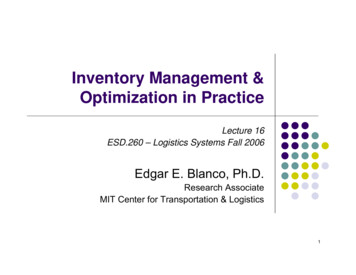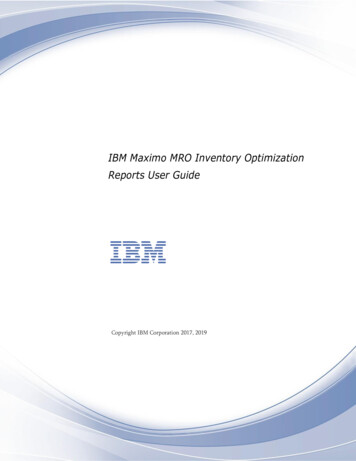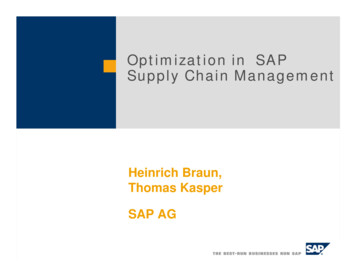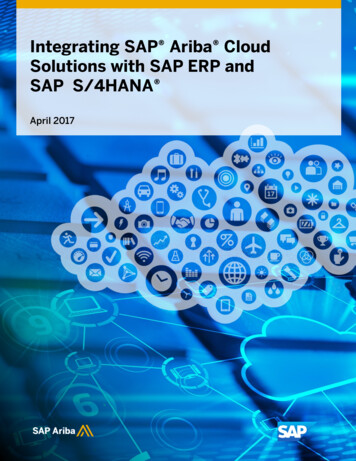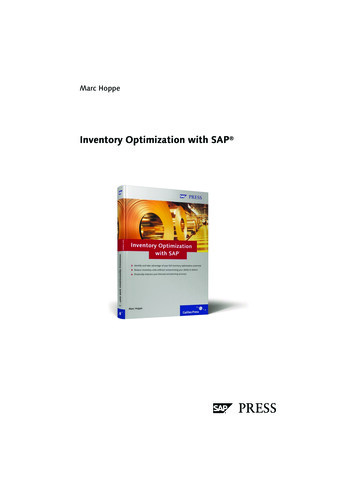
Transcription
Marc HoppeInventory Optimization with SAP
Contents at a GlanceIntroduction .191Why Inventory Is Necessary .272Factors Influencing Inventory .453Inventory Analysis .534Demand Planning and Forecasting .935Material Requirements Planning . 2076Service Level and Safety Stocks . 2577Lot Sizes . 3258Production . 3659Inventory Controlling . 43710Afterword . 467ALiterature . 473BThe Author . 475Index . 477
ContentsIntroduction .191Why Inventory Is Necessary .271.1Different Inventory Concepts .1.1.1 Inventories as Enabling Agents .1.1.2 Inventories as Concealers of Weak Processes .1.1.3 Inventory as an Adjusting Screw .Uncertainties in the Supply Chain .1.2.1 Demand-Side Uncertainties .Consumption Variances .1.2.2 Supply-Side Uncertainties .Delivery Date Variances .Delivery Quantity Variances .Price Variances .Inventory Variances .How to Deal With Uncertainties .1.3.1 Demand-Side Optimization Potentials .1.3.2 Supply-Side Optimization Potentials .1.3.3 Comprehensive Optimization Measures .28283235363737373738383939404143Factors Influencing Inventory .452.1Five Instruments .2.1.1 Demand Planning .2.1.2 Material Requirements Planning (MRP) .2.1.3 Service Level and Safety Stocks .2.1.4 Lot Sizes .2.1.5 Production .Controlling by Inventory Monitoring .45464748505052Inventory Analysis .533.15454606162631.21.322.233.2Inventory Analysis Options .3.1.1 ABC Analysis .3.1.2 XYZ Analysis .ABC Analysis With SAP .3.2.1 Outlining the Analysis Process .3.2.2 Determining the Analysis Goal .7
Contents3.2.33.2.43.2.5Defining the Area to be Analyzed .Calculating the Data Basis .Defining the ABC Strategy .Total Key Figure (%) .Number of Characteristic Values (%) .Key Figure (absolute) .Number of Characteristic Values .3.2.6 Defining Class Limits .3.2.7 Assigning Classes .3.2.8 Evaluating an ABC Analysis .Totals Curve .3D Graphic .3.2.9 Performing an ABC Segmentation .3.2.10 Case Scenario: ABC Analysis for WarehouseOptimization .3.2.11 Case Scenario: ABC Quantity Flow Analysis .XYZ Analysis With SAP .3.3.1 Running Analyses in mySAP ERP .3.3.2 Performing Valuations in Excel .Combining ABC and XYZ Analyses .3.4.1 Optimization Using the ABC-XYZ Matrix .Deriving Optimization Potentials .An Example from the Trading Industry .3.4.2 An ABC-XYZ Matrix With SAP .77798181848787878990Demand Planning and Forecasting .933.33.444.14.24.38The Influence of Demand Planning on Inventories .The Bullwhip Effect .Optimization Potentials for the Forecast .4.3.1 Analyzing Market Influences .Market Dynamics .The Marketplace .Competitors .4.3.2 Analyzing Product Influences .Product Lifecycle .Cannibalization .Lifecycle Planning Using SAP APO .Like Modeling .Phase-in-/Phase-out Modeling .4.3.3 Creating a Consistent Data Basis .Historical Consumption (Actual Data) 2102103104106106
Contents4.44.5Data Quality Requirements .Correcting the Historical Data Basis .Correcting the Work Days .Correcting Outliers .Time Series Patterns .4.3.4 Defining the Optimal Forecast Horizon .Flexibility by Short Forecast Horizons .Defining the Forecast Horizon in SAP APO .4.3.5 Considering Promotions .Segmenting Promotions .Forecast Horizon for Promotions .Allocations with Scarce Supplies .Cannibalization in Promotions .Separating the Promotion Data Basis .The Promotion Planning Process .Promotion Planning in SAP APO .4.3.6 Defining Forecast Responsibilities .Forecast Levels (Aggregation/Disaggregation) .Sales Goals and Bonuses Based on ForecastAccuracy .Selecting the Forecast Method .4.4.1 Different Forecast Methods .Qualitative Forecast Methods .Quantitative Forecast Methods .Time Series Analysis (Univariate Models) .Causal Models .Naive Methods .Composite Forecast Methods .4.4.2 Procedure Model for the Selection .Step 1: Data Analysis .Step 2: Selecting the Selection Model .Drawbacks of Automatic Model Selection .Details of the Individual Forecast Methods .4.5.1 Unstable Demand and Incomplete History .Manual Forecast .Moving Average Model .Weighted Moving Average Model .Composite Forecast Methods .Bass Model .Two-Points Function 1481491491501511529
Contents4.5.24.64.710Stable Demand and Incomplete History .Constant Model of First-Order ExponentialSmoothing .Trend Models and Seasonal Models of FirstOrder Exponential Smoothing .Models of Second-Order ExponentialSmoothing .The Holt Procedure .The Winters Procedure .4.5.3 Unstable Demand and Complete History .Seasonal Linear Regression .The Croston Method .Box-Jenkins Method/ARIMA .Median Method .4.5.4 Stable Demand and Complete History .Multilinear Regression (Causal Models) .Lifecycle Forecast .Summary .Running a Forecast .4.6.1 Configuring the Settings .Step 1: Optimizing the Parameters .Step 2: Composite Forecast .Step 3: Forecast Periods .Step 4: Promotions and Events .4.6.2 Running a Forecast in SAP APO .The Demand Planning Desktop .Running the Forecast .Forecast Analysis .Forecast Comparison .Forecast Accuracy and Alert Functions .4.7.1 Ex-Post Forecast .4.7.2 An Overview of Forecast Errors .4.7.3 Univariate Forecast Errors .Error Total .Mean Absolute Deviation (MAD) .Mean Square Error (MSE) .Root of the Mean Square Error (RMSE) .Absolute Percent Error (APE) .Adjusted Absolute Percent Error (APE-A) .Mean Absolute Percent Error (MAPE) 191191193193
ContentsMedian Absolute Percent Error (MdAPE) .Relative Absolute Error (RAE) .Median Relative Absolute Error (MdRAE) .Geometric Mean Relative Absolute Error(GMRAE) .Tracking Signal .Theil Coefficient .Summary of Univariate Errors .Causal Forecast Errors (MLR) .R Square .Adjusted R Square .Durbin-h .Durbin-Watson .t-Test .Mean Elasticity .Forecast Errors in SAP APO .Comparability of Forecast Errors .Comparable Data Basis .Comparable Forecast Periods .Comparable Aggregation Levels .Comparable Points in Time .Forecast Accuracy .Alert Monitor 02203204Material Requirements Planning 314.7.44.7.54.7.64.7.74.7.855.25.35.4MRP Strategies .5.1.1 Requirements Calculation .5.1.2 Balance Accumulation .5.1.3 Order Calculation .Impact of Material Requirements Planning on Inventory .Strategies for Make-to-Stock Production in mySAP ERP .5.3.1 Planning with Final Assembly (40) .5.3.2 Production by Lot Size (30) .
Contents 13 Delivery Flexibility . 265 Delivery Quality . 266


